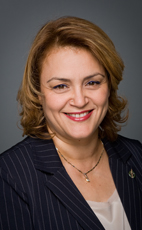Mr. Speaker, I would like to thank my colleague, the member for Etobicoke North, for the energy and passion she has put into the cause of multiple sclerosis.
Canada is one of the countries most affected by this illness. It is believed that between 50,000 and 80,000 Canadians are affected, and three new cases are diagnosed every day in Canada. What is dramatic is that the people who are diagnosed with multiple sclerosis are in their prime. They are usually between 15 and 40. So these are young people who are active in the labour force and have a family, or people who are dreaming of changing the world and making a contribution to our society.
Learning that your body is an obstacle to achieving your goals is a hard reality to face and difficult to accept. The symptoms of multiple sclerosis vary from person to person. They range from blurred vision and extreme fatigue to trouble speaking and muscle stiffness. The most severe cases can involve memory problems and partial or full paralysis. With this illness, you need help from your loved ones, at least some of the time. So I hope that this government will do more for informal caregivers, who often must take time off work and bear the costs of caring for their loved ones.
The reality is no rosier for patients. Almost 80% of multiple sclerosis patients end up unable to do full-time work. So it is urgent to give those people the flexibility they need so that they remain active and stay out of poverty. This is even more important when we realize that 75% of patients are women. I remind the House that more women than men live on a low income. One of the objectives of the Multiple Sclerosis Society of Canada is to improve the system of employment insurance sickness benefits so that compensation can be paid when work is missed because of flare-ups. I hope the government is listening.
At the moment, multiple sclerosis is incurable. A number of treatments can slow the progress of the disease and reduce the frequency of the attacks or the intensity of the symptoms. But nothing yet lets patients tell their loved ones that they are cured. So we should not be shocked to learn that a 2009 announcement of a potential cure gave Canadians a lot of hope. But they are frustrated at not having access to it here. The treatment in question was developed by Dr. Paolo Zamboni. He feels that an obstruction in certain parts of the system of veins in the neck and the head makes that system unable to drain the blood effectively from the brain and the spinal cord. This could be the cause of the iron deposits in the central nervous system which provoke an immune response associated with multiple sclerosis.
The proposed treatment, the possible therapy, consists of an angioplasty, in which veins are opened and a small balloon or a vascular stent is inserted. The first trials that Dr. Zamboni conducted were very promising. But the scientific community is still very cautious. In fact, the cause of the disease that Dr. Zamboni suggests was not considered by experts until now. After the shock that the initial discovery caused, a number of studies have been undertaken on various aspects of the theory; the results are inconclusive to say the least. Some support Dr. Zamboni's conclusions, others reject them.
As a physician, I have to admit that I am both intrigued with and skeptical of the theory that Dr. Zamboni is putting forward. I am intrigued because he seems to have achieved results and because, if his research turns out to be valid, it will be a major advance in medical research. But I am skeptical not only because the research is not complete but also because it is not the first time that a miracle cure for multiple sclerosis has been announced. I have in mind the 1988 announcement by a French doctor, Dr. Le Gac, that the disease could be cured with high doses of antibiotics because it was caused by a virus.
It is my wish that the treatment will be available as soon as possible for all those who need it and that it will be proven effective. Patients are putting a lot of hope into the procedure.

